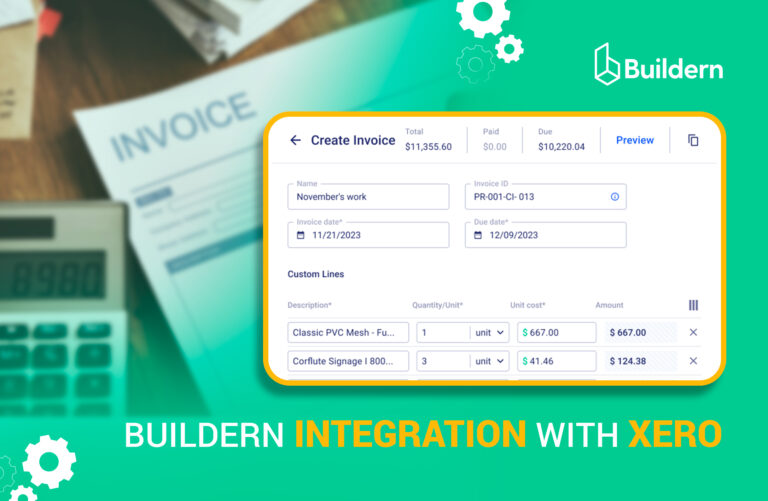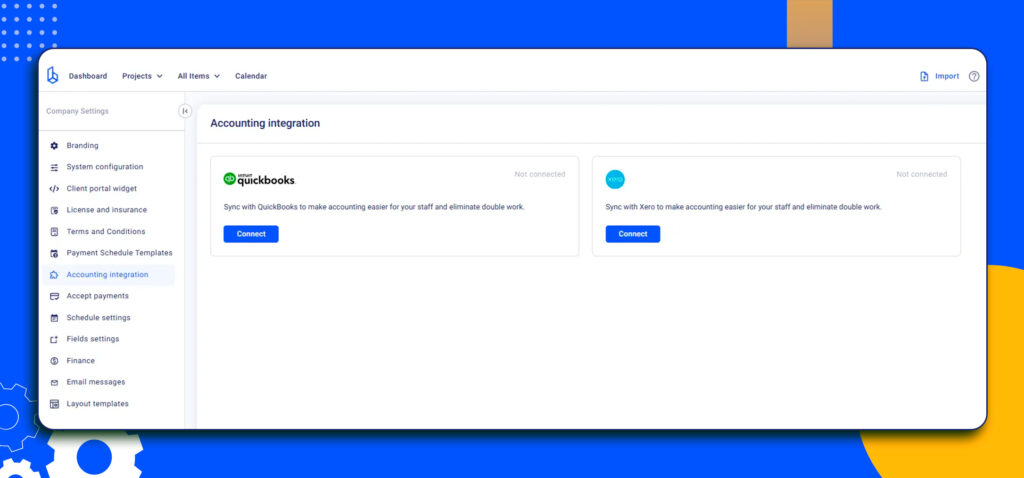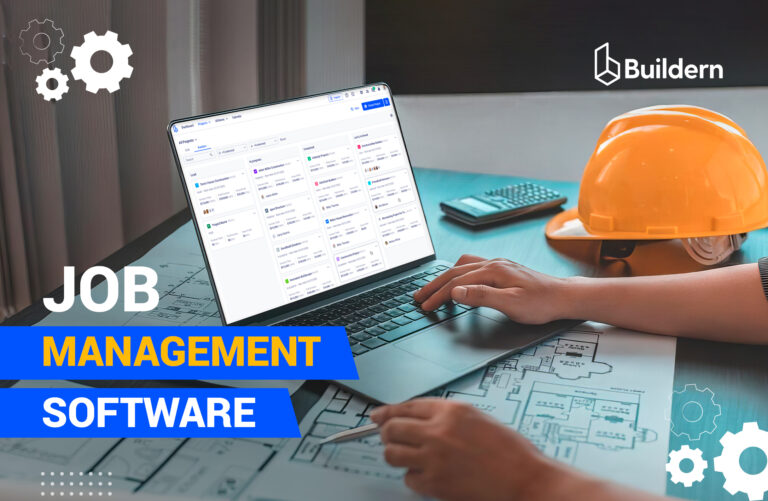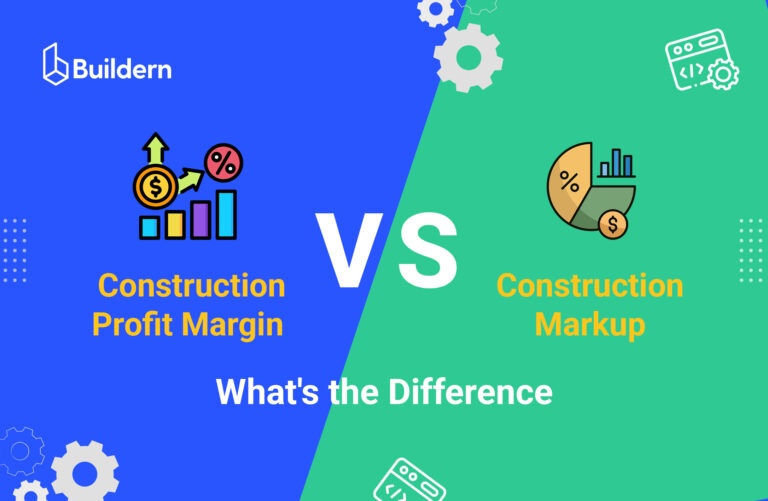Tips on Xero Integration: How to Streamline Your Invoicing?

Are you tired of writing one invoice? Imagine a general contractor writing dozens of them weekly.
For me, working with numbers has been the most frustrating part of running a construction business. However, accurate accounting is the background of a successful project. Whether you like it or not, you have to take care of it. And, whoever does it, it’s crucial to choose the right tools to save time and not to lose money.
In this case, I recommend considering construction management software platforms that have full integration with accounting tools. In this blog, I will cover how Buildern integrates with Xero and will recommend the best practices to get the most out of this integration.
Table of Contents
- What Is Invoice Software?
- Understanding Xero Integration for Construction Business
- Buildern and Accounting Integration
- How to Integrate Xero with Buildern?
- Best Practices to Maximize Integration Benefits
- Key Highlights
What Is Invoice Software?
Based on my experience, accounting takes much time and effort, and sometimes distracts builders from the things they do best: building.
Besides, construction accounting comes with unique challenges. From my experience, the projects can sometimes span months, and there is no guarantee that payments won’t arrive late. Therefore, we need client invoicing software that automates the creation, delivery, and tracking of invoices.
For construction companies, this means transforming how you bill clients, track payments, and manage project finances. When I moved from handwritten invoices, it seemed to be a groundbreaking discovery. However, technologies move forward, and now even spreadsheets are not enough.
Today, financial overflow cannot exist without automated billing systems that save time and reduce errors. Of course, using spreadsheets and other files still exists, but it will hardly allow you to stay competitive.
Understanding Xero Integration for Construction Business
Xero offers a cloud-based solution that adapts well to the realities of project-based work. It allows contractors to keep financial data organized and accessible.
While Xero is used globally, it has built a particularly strong presence in Australia and New Zealand. It remains the dominant choice for many small and medium-sized businesses, including construction firms.
Although Xero was not developed exclusively for construction companies, it offers a range of features that can address unique billing issues.
The problem is that in construction, invoicing is rarely straightforward. There are progress payments, retainage amounts, and change orders that complicate the construction overflow. Xero helps in dealing with bills to avoid delays and repetitive tasks.
Key Features of Xero for Construction
This software comes with many functions that the builders can use in their daily operations. I will highlight some of the most frequently used:
- Customizable Invoices
Invoices can be aligned with project-specific details, cost codes, and line items. It gives clients clarity on what they’re being billed for. - Progress and Retention Billing
Xero allows contractors to issue invoices for partial project completions and manage retention amounts. This ensures payment schedules align with construction milestones. - Automated Reminders and Online Payments
Late payments are a common issue. Here, contractors can set up automated reminders and offer online payment options, reducing collection times. - Recurring Invoices for Long-Term Contracts
For maintenance work or ongoing service agreements, Xero supports recurring billing, saving contractors the hassle of recreating invoices each cycle. - Mobile Invoicing
It is possible to send invoices directly from their phones.
Buildern and Accounting Integration
From my experience, financial management in construction starts long before you start building something. First comes estimating costs, sending bids, and setting budgets.

Buildern is designed to handle these financial processes from scratch. Thus, accounting becomes a seamless part of project management rather than a separate, time-consuming task.
When a new project is created in Buildern, you can immediately set up its financial structure. Budgets, cost codes, and payment terms are determined from the start.
As the project moves forward, it becomes easier to control daily financial operations. Everything is synced and generating progress invoices, recording subcontractor payments, or tracking material costs is done in a few clicks. Everything remains linked to the original budget, giving you real-time visibility.
Believe me, this doesn’t mean you have to abandon the tools you have used in the past. Buildern integrates smoothly with both Xero and QuickBooks, the most popular accounting software.
Invoices, bills, and payments flow automatically between systems, eliminating the need for repetitive data entry.
How to Integrate Xero with Buildern?
Managing projects and accounting are two simultaneous processes. When picking the project management software, I looked for a platform that could better integrate with the accounting software I use.
Xero integration with Buildern helps general contractors connect their financial data with their project management workflows. As a result, you have fewer errors and faster payments.
When you open a new project in Buildern, one of the first steps is to set up its accounting system. Here, you can choose to link the project directly with Xero.

This connection ensures that invoices, bills, and payments created in Buildern are automatically reflected in Xero.
What Can You Sync in Buildern and Xero?
The integration is designed to work smoothly at all levels. For example, if I generate a progress invoice in Buildern, the same invoice appears in Xero with all project-specific details. Payments recorded in Xero will also sync back, keeping your project financials up to date.

Let me show what goes from Xero to Buildern and vice versa:
- Bills and Expenses: Bills entered in Xero, such as supplier invoices or utility costs, can be pulled directly into Buildern.
- Payments: When payments are recorded in Xero, they sync back into Buildern, keeping project-level financials up to date.
- Invoices: When you create an invoice in Buildern, it automatically syncs to Xero with all the project details included. This ensures clients and accountants see the same data without re-entering information.
- Cost Codes: Xero’s products and services databases can be synced with Buildern’s cost codes. This alignment makes financial reporting consistent across both systems.
- Subcontractors and Vendors: Any subcontractor or vendor added in Buildern can be synced to Xero’s contacts list, so supplier payments and bills are always tied to the right entities.
- Projects: Syncing projects keeps both your project crew and your accounting team on the same page.
The result is you have data in Xero and Buildern without the risk of having errors. It becomes a natural part of project management, automatically reflected on both platforms. No additional efforts are needed to keep financial information accurate.
Best Practices to Maximize Integration Benefits
Integrating two platforms is the first step. It’s crucial to maintain the flows in a way that gets the most value out of this connection. When I first synced it, I adopted a strategic approach. The following best practices help ensure smooth financial management across both platforms.
Set Up Accounting Early
The first tip is to connect Xero once you add a new project. This way, every estimate, budget line, invoice, and bill is tied to the right accounting records.
Setting things up early eliminates the need for messy reconciliations later, when mismatched numbers or missing documents can cause delays. It also helps project managers and accountants work in sync.
Train Your Teams
Integration works best when everyone knows their role. If you have a project management system and someone is dealing with the accounting, show the crew how the process will be displayed in both platforms. In short, explain how it works.
Provide basic training on how Buildern and Xero sync, what each team member can access, and how to troubleshoot common issues like duplicate entries or failed syncs.
Project managers need visibility into budgets and invoicing, and accountants need access to bills and reconciliations. In addition to customer support, Buildern holds onboarding sessions to help you sync all data and have a better understanding of the software.
Use Consistent Cost Codes
Cost codes are an important part of accurate reporting. By aligning Buildern’s project cost codes with Xero’s products and services, contractors can maintain consistency across both systems. This prevents confusion when comparing project performance to overall company financials.
Streamline Tax Preparation and Reporting
One of the biggest advantages of integrating platforms is the ability to simplify tax season and ongoing financial reporting. A good practice is to keep your financial records organized and tax-ready. With Buildern and Xero working together, every payment is properly categorized and synced for accurate calculations. Real-time financial reports give you insights into cash flow and job costs.
Why Integrate Xero with Buildern?
If the accounting of a construction firm is done with Xero, integrating it with Buildern means you have to track one tool instead of juggling between two platforms. This reduces manual entry and ensures your financial data is always up to date. Project managers gain visibility into real-time costs, while accountants can rely on accurate records for reporting.
How Does Integration Help During Tax Season?
All invoices, bills, and payments are automatically categorized and synced. The financial records remain accurate. Autopmaion reduces last-minute changes and makes tax filing faster and less stressful.
What Happens If a Payment Is Entered in Xero but not in Buildern?
Payments recorded in Xero sync back into Buildern automatically, keeping your project data updated without extra manual work.
Is Xero Integration Difficult to Set Up?
No, it’s easier than you think. It takes just a few clicks to configure Xero on Buildern, pulling bills and expenses.
Key Highlights
Building firms usually struggle to find the best system to cover all their needs. When signing up to Buildern, there is no need to abandon the accounting platforms you were using.
All information can be easily pulled from Xero and is further visible both on Xero and Buildern. Pairing invoicing tools with Buildern’s project management workflows creates a smooth connection between the contractor’s usual workflow and accounting. As a result, no detail is omitted.


